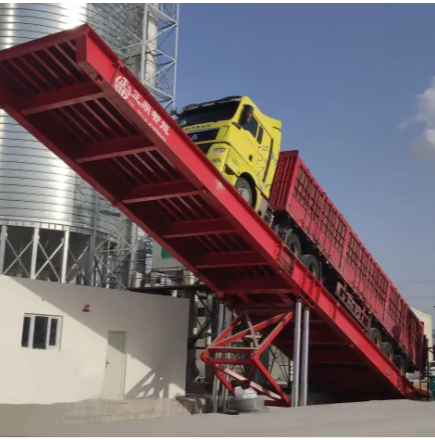Essential Pre-Unloading Safety Checks
Inspecting Truck Stability and Braking Systems
Safety starts with making sure the truck stays stable when it comes time to unload. Before anything else, drivers should check out those tires, take a good look at the brakes, and give the hitch a once over to see if everything seems okay. These basic checks do more than just keep things steady they actually cut down on accident chances while working around loaded vehicles. Don't forget about how weight sits in the truck bed either. Uneven loads create serious tipping hazards, so spend some time walking around and visually confirming balance. Got access to a leveling tool? Great, put it to work verifying that cargo isn't going to shift unexpectedly. And let's talk about those mandatory DOT inspections too. They're not just paperwork exercises. A proper walk through according to transportation regulations catches small problems before they turn into big headaches down the road.
Verifying Load Securement Before Unloading
Safety during unloading depends heavily on proper load securement. First things first check those restraints like straps and chains to make sure nothing looks worn out or loose. They need to hold firm so stuff doesn't shift around or fall off while moving things. Take a good look at the whole load too. Any visible movement from the journey? That's a red flag right there. Following FMCSA cargo securement rules isn't just paperwork it actually keeps everyone safe on the road and at loading docks. The agency knows what works best for various cargo types through years of experience, so their guidelines matter quite a bit when securing freight properly.
Testing Hydraulic Equipment and Lift Mechanisms
Before starting any unloading work, it makes sense to test hydraulic equipment and lift mechanisms thoroughly. A good practice involves running functional checks on all hydraulic systems to make sure they actually work when pressure builds up during operation. For lift mechanisms, regular inspections help spot signs of wear like frayed cables or worn-out bushings that might lead to failure down the road. Keeping detailed records of these tests isn't just paperwork - following safety standards for documentation creates clear accountability. When problems show up in the records, they get fixed faster instead of being overlooked. This approach keeps everyone safe while staying compliant with industry requirements throughout the entire unloading process.
Loading Zone Setup and Visibility Protocols
Designating Clear Truck Unloading Areas
Putting up clear signs at specific unloading spots helps truck drivers and workers know exactly where to go. Good markings make it easy to spot safety zones around trucks, which keeps things running smoothly during loading and unloading operations. Keeping these areas clear of anything blocking them gives everyone enough room to move around safely and cuts down on accident risks. Companies should check these zones regularly maybe once every few months or after major changes in operations to make sure they still work well for current needs. After all, nobody wants to see a pileup just because someone parked their equipment in the wrong place.
Ensuring Proper Lighting and Signage
Good lighting makes all the difference when unloading cargo, particularly when visibility drops at night or during bad weather. Proper illumination does more than just keep people safe it actually helps streamline operations too. Adding reflective signs around the site really boosts how visible those important warning messages become, plus they make it easier for staff to find their way through the area without getting lost. Maintenance crews need to check everything regularly, making sure lights stay on and signs aren't faded or damaged. A quick weekly walk through these zones catches problems before they turn into serious safety issues down the line.
Implementing Traffic Control Measures
Good traffic management at loading docks makes all the difference when it comes to keeping people and vehicles moving safely. Putting out traffic cones, setting up physical barriers, and having experienced flaggers on site really helps prevent accidents while trucks are loading or unloading goods. Workers need regular refresher courses on how to handle traffic situations properly too since mistakes happen more often than we'd like to admit. These basic precautions do more than just check boxes on safety lists they actually save lives and keep delivery schedules running smoothly without unnecessary delays caused by preventable incidents.
Worker Safety During Truck Unloading Operations
Mandatory PPE Requirements for Unloading Crews
The first step toward keeping unloading crews safe comes down to following PPE guidelines without exception. Everyone working these operations needs to have proper gear on site at all times - think hard hats, work gloves, those bright orange vests that actually make people visible. Getting training isn't just nice to have either. Workers need to know how to put on, take off, and maintain their equipment properly so they aren't left exposed when things go wrong. Regular checks throughout the facility also play a role here. Management should be walking around making sure everyone's got their stuff on right. These spot checks remind staff why wearing protection matters while catching any gaps before someone gets hurt. While no system can eliminate all risk completely, consistent attention to PPE details makes a real difference in preventing injuries during unloading tasks.
Safe Positioning Around Suspended Loads
When dealing with anything hanging overhead, setting up clear no-go areas underneath those loads is absolutely essential for worker safety. Nobody wants someone getting hurt because they wandered too close while something heavy was moving above them. Training needs to cover not just what the rules are but also where exactly workers need to stand in relation to cranes or hoists. Some companies even mark out floor zones with bright tape so everyone knows where it's unsafe to go. Safety drills aren't just box ticking exercises either. Real practice scenarios make all the difference when panic sets in during an actual emergency. The more familiar workers become with how to react quickly without thinking, the better chance we have of preventing accidents altogether.
Communication Protocols Between Staff
Good communication is absolutely necessary when things are being unloaded to stop accidents and keep everything running smoothly. Workers need clear ways to talk to each other during these operations, whether through basic hand signals or just grabbing a radio for longer distances. Before starting work, it helps to have those quick meetings at the beginning of shifts where everyone knows what their job is, gets reminded about safety rules, and can point out any dangers they spot. Companies should really push for a workplace culture where employees aren't afraid to speak up about unsafe conditions or come forward with ideas on how things could be done better. When people actually feel heard and valued for their input, the whole operation tends to run much safer overall.
Material Handling and Hazard Mitigation
Proper Lifting Techniques for Heavy Items
Getting the right technique down when lifting heavy stuff from trucks can really cut down on workplace injuries. Workers need proper training in how to lift safely, focusing on keeping good posture and moving correctly so their backs don't take unnecessary stress. Companies would do well to invest in equipment like dollies or small forklifts wherever possible these days since they make a big difference in减轻ing the load on employees' bodies. Management needs to keep an eye on what's happening out there too. Regular checks help make sure everyone actually follows those safety rules instead of just reading them once and forgetting all about it.
Containment Strategies for Hazardous Materials
Good containment plans are absolutely key when dealing with dangerous stuff during unloading operations. Companies need solid rules about how to handle and store these materials if they want to avoid accidents happening. Putting in place proper spill containment systems makes a real difference in limiting environmental damage should something go wrong with leaks or spills. Workers must get proper training on all the hazardous material protocols too. This includes knowing when and how to wear protective gear properly and what steps to take in emergencies. Safety just doesn't happen by accident after all.
Emergency Procedures for Equipment Failure
Getting ready for when things go wrong with equipment matters a lot for keeping the unloading area safe. Workers need clear steps to follow whenever machinery breaks down while loading or unloading cargo. The plan should cover what to do right away to cut down risks and stop anyone from getting hurt. Everyone working there must know these emergency protocols inside out, which means regular practice sessions so nobody freezes when something actually happens. Some companies even simulate different failure scenarios monthly just to keep everyone sharp. And let's not forget about having phone numbers and contact info posted where everyone can see them. Nobody wants to waste precious minutes trying to find who to call during an actual crisis. Good preparation saves lives and prevents costly downtime too.
Regulatory Compliance and Training Standards
OSHA Requirements for Truck Unloading Safety
Following OSHA rules makes truck unloading operations much safer for everyone involved. Workers handling these tasks need to know what the regulations actually say so they can avoid common mistakes that lead to injuries on site. Companies should run regular checks through their facilities to see if workers are sticking to proper protocols and spot any risky situations before they become real problems. These routine inspections aren't just paperwork exercises they actually keep people safe by looking at how things are currently done and fixing whatever doesn't work right. And don't forget to record every safety training session too. Having those records proves the company cares about worker protection and meets all the legal stuff that comes with running a business safely.
FAQ
What are the essential pre-unloading safety checks?
Essential pre-unloading safety checks include inspecting truck stability and braking systems, verifying load securement, and testing hydraulic equipment and lift mechanisms for safe operations.
How can load securement be verified before unloading?
Load securement can be verified by inspecting all load restraints such as straps and chains, ensuring they are intact and securely fastened to prevent shifting or falling loads.
Why is testing hydraulic equipment important during unloading?
Testing hydraulic equipment is important to avoid accidents during unloading by confirming systems operate correctly under pressure and ensuring lift mechanisms are free from potential wear and tear.
What safety measures should be in place for truck unloading zones?
Safety measures for truck unloading zones should include clear demarcations, proper lighting and signage, and robust traffic control measures to ensure safe operations.
What PPE is mandatory for unloading crew?
Mandatory PPE for unloading crews includes hard hats, gloves, and high-visibility vests to ensure personal safety during unloading operations.
How can communication protocols enhance unloading safety?
Communication protocols such as pre-shift briefings and tools like radios or hand signals can enhance unloading safety by ensuring effective communication among staff, preventing accidents, and promoting a smooth execution of tasks.
Table of Contents
- Essential Pre-Unloading Safety Checks
- Loading Zone Setup and Visibility Protocols
- Worker Safety During Truck Unloading Operations
- Material Handling and Hazard Mitigation
- Regulatory Compliance and Training Standards
-
FAQ
- What are the essential pre-unloading safety checks?
- How can load securement be verified before unloading?
- Why is testing hydraulic equipment important during unloading?
- What safety measures should be in place for truck unloading zones?
- What PPE is mandatory for unloading crew?
- How can communication protocols enhance unloading safety?

